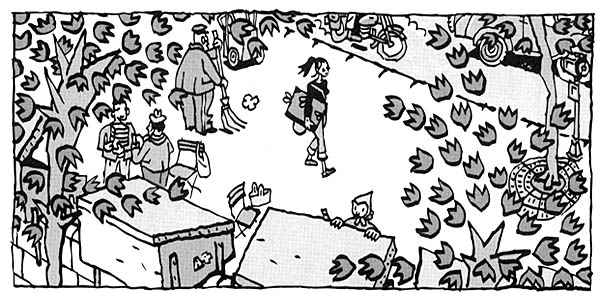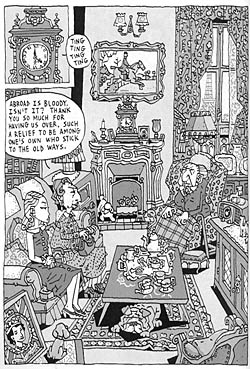 Written by Andi Watson
Written by Andi Watson
Art by Simon Gane
144 pages, black and white
Published by SLG Publishing
For someone who loves most of Andi Watson’s creations, I really have no idea why it’s taken me this long to finally read Paris. It’s been a strange sort of blind spot amidst books like Breakfast After Noon, Slow News Day, or Glister. And now that I’ve read it? I must admit that it wasn’t at all what I was expecting from Watson.
Juliet is an American living in Paris, an art student taking portrait assignments from her piggish art professor in an attempt to make a living. When she’s assigned to paint Deborah, a young British socialite, Juliet figures it’s nothing out of the ordinary. Who she finds is a woman desperate to escape her oppressive family, and Juliet can’t help but be drawn to her. But can they have a happy ending, or will their living in different worlds keep them apart?

I have a confession to make—at first I really wasn’t enjoying Paris. It seemed strangely old-fashioned, with attitudes that felt a little archaic in this day and age. Several times I found myself muttering, "Are there still really people who think this way?" It just seemed hard to believe, a strange sort of misplaced attitude throughout the book. I finally put the book down to get a drink, and when I came back I glanced at the back cover copy of book.
Juliet is a penniless American art student in early 1950s Paris…
 Well then! This suddenly made much more sense. We weren’t supposed to believe that people like this existed now, it was taking place 60 years ago. The thing is, after I finished the book, I went back through the book and looked for some sort of reference to the time period that I’d missed. I was both a little relieved and disappointed to see that it wasn’t actually there. It’s the big problem I had with the writing, the sneaking feeling that some of the plot details I was missing in the book only existed on the back cover description. There seemed to be more familial conflict promised there than we actually got, and likewise the promised love of art that brings them together felt almost incidental. The core of the book is still good, and I do think that the relationship between Juliet and Deborah comes across very well. It just doesn’t seem to be what’s promised.
Well then! This suddenly made much more sense. We weren’t supposed to believe that people like this existed now, it was taking place 60 years ago. The thing is, after I finished the book, I went back through the book and looked for some sort of reference to the time period that I’d missed. I was both a little relieved and disappointed to see that it wasn’t actually there. It’s the big problem I had with the writing, the sneaking feeling that some of the plot details I was missing in the book only existed on the back cover description. There seemed to be more familial conflict promised there than we actually got, and likewise the promised love of art that brings them together felt almost incidental. The core of the book is still good, and I do think that the relationship between Juliet and Deborah comes across very well. It just doesn’t seem to be what’s promised.
Simon Gane’s art in Paris is unfortunately not helped by the black and white (with graytones) format of the book. I don’t think it’s any coincidence that my favorite art from Gane is on the covers, where he’s able to use full color to give a level of depth and three-dimensionality to his art. In black and white, that all seems to vanish; the art is enormously flat and lacking perspective. The very first panel shows an aerial view of Juliet walking down the street, with the reader’s viewpoint coming in through branches and leaves of trees. The problem is, it looks like there are massive leaves the size of cannonballs littering the street; it takes a second to really look like these items are far away from her. It’s a shame, because Gane’s art style is a very intriguing one; there are lots of intricate little wiggles and angles that make up all of their figures, jagged edges that make me think of art created using an extremely sharp pair of scissors. I’d really love to see Gane draw a full-color book, because I think it would keep everything from looking so flat. But when a woman sitting in a chair on the right-hand side of a page seems to vanish into the background and almost slip by unnoticed, well, it’s a problem.
In the end, I liked Paris, but I must admit that I didn’t love it the way I have some of Watson’s other books. If I’d never read anything by Watson I think I’d be really pleased with Paris and think that I would want to see more by him. There are definitely things to like about Paris after all. The fourth chapter standing apart and yet so much a part of the rest of the book is a technique I wish more writers would use, and it’s to great effect here. The overall heart and emotion of the book really grabbed me. But there are lots of little gaffes and halfway-there pieces of the puzzle that were hard to ignore. A nice afternoon read, but probably not a book that will stick in my memory like so many other books from Watson have.
Purchase Links: Amazon.com
